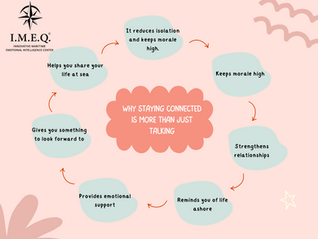Limiting noise induced hearing loss in crew
- IMEQ CENTER

- Nov 10, 2023
- 4 min read

The UK P&I Club PEME Programme provides an enhanced medical screening service for all crew. As part of the PEME examination, crew are screened on all the major body organs and functions. Data collected from the medical examinations is regularly analysed and the results used for identifying trends in crew health. Hearing defects have consistently featured as a cause of PEME failures, and currently account for 11% of the Club's PEME unfitness statistics. The Club has noted the largest group of seafarers who are affected by abnormal audiometry results work in engine rooms. Typically, crew with poor audiometry results also display signs of mild to moderate high frequency hearing loss. Seafarers working in engine rooms have a higher tendency to experience hearing disabilities.This is especially true for crew who do not use precautionary measures.
High levels of ambient noise, typically above 85 dBA cause noise-induced hearing loss (NIHL). The negative effects of such levels of noise and higher, depend upon individual physiology and the duration of exposure.
Identification and limitation of hearing damage
Audiometric testing is included as part of the UK Club PEME examination. It is the only diagnostic evaluation relevant to indicate noise-induced hearing loss (NIHL).The screening is performed by an audiometric testing machine within a sound proof booth, which provides an accurate measure of any damage. The following features are essential for a robust hearing conservation program:
A baseline audiometry test to be performed within six months of exposure for all seafarers. The test should ideally be performed when the seafarer has not been exposed to hazardous noise for at least 14 hours.
Seafarers exposed to higher noise levels may be required to attend training on the effects of loud noises on hearing, the purpose of audiometric testing and protective devices available to mitigate the effects of noise damage.
As exposure to loud noises, such as in engine rooms, is unavoidable on ship, hearing protection within these areas is mandatory.Devices for hearing protection including earplugs or earmuffs can be easily sourced and used onboard.The most effective ear protection is the ear protector.
Allow breaks for seafarers between each episode of exposure to loud noise (more than 85 dB) especially when sound levels are higher and prolonged.
A Physician's perspective:
Dr. M.K.E. Memon (MBBS, MCPS, MRSH), Consulting Physician at Kaifak Medicare, one of the Club's approved PEME clinics in Mumbai, India comments as follows. “As a medical professional working in maritime health, I am very concerned about the prevalence of noise-induced hearing loss among seafarers. It has been noted that the ability to understand spoken words depends on the ‘signal to noise’ ratio, which is often compromised by exposure to loud noise. It has been estimated that even under the best conditions (noise-free), only 30% to 40% of speech sounds can be lip-read. Hence, it is crucial to take preventative measures to limit noise exposure and improve auditory reception. One effective way to limit noise-induced hearing loss is by using ear muffs or plugs. Clinical research has shown that ear muffs can reduce noise exposure up to a certain extent and minimize the risk of damage. Seafarers should use ear muffs or plugs all the time in noisy areas, but they should not be ill-fitted. However, in extreme hot and humid climates, there are chances of skin irritation or skin infection around the external ears. It is important to note that ear muffs reduce both the level of noise and any communications by the same amount. Therefore, it may be difficult to hear conversations, alarms, and abnormal sounds with or without ear muffs. To address this issue, ear muffs can be incorporated with ‘telecoms receivers’ within, so that it can enhance emergency sound reception, thus encouraging the use of ear defenders. Pure tone audiometry provides a valid and reliable way of determining hearing loss in each ear across a range of frequency from low to medium to high. The noise-induced hearing loss can very well be evaluated by pure tone Audiometry. It is essential to emphasize audio-metric testing to detect hearing loss early and take preventive measures. During the course of PEME, the whisper tests are subjective in its characteristic way. Hence, this test should not be encouraged by a physician. Communication difficulties between crew members should also be taken into consideration as an important evidence of hearing impairment. Lip-reading/ face-to-face speech is better than for ‘telecommunication’ as there are non-hearing clues about content. However, technically improved gadgets such as wider-band with noise cancelling/exclusive headsets or earpieces can improve reception of auditory information. Lastly, during REM sleep, people can hear and respond to simple questions. Most sensory stimuli do not reach conscious perception during sleep except the sense of hearing. Vibrating alarms or bright flashing lights can be used as an audible warning to wake a seafarer having mild to moderate hearing defects from sleep, during emergencies, while on board. In conclusion, limiting noise-induced hearing loss should be a priority for seafarers’ safety and health. We need to encourage the use of ear muffs or plugs, incorporate ‘telecoms receivers’ within ear muffs to enhance emergency sound reception, and emphasize audio-metric testing to detect hearing loss early. Let us work together to ensure the safety and well-being of seafarers.”
Thanks to: Dr. M. K. E.Memon MBBS, MCPS, MRSH – Kaifak Medicare Pvt. Ltd. Kaifak Medicare website: https://www.kaifakmedicare.com/
UK P&I Club are contributing Loss Prevention and Crew Health materials for the IMEQ Seafarers App as part of our established partnership. For further information on the UK P&I Club Loss Prevention and Crew Health activities please see www.ukpandi.com





































































































Very interesting article